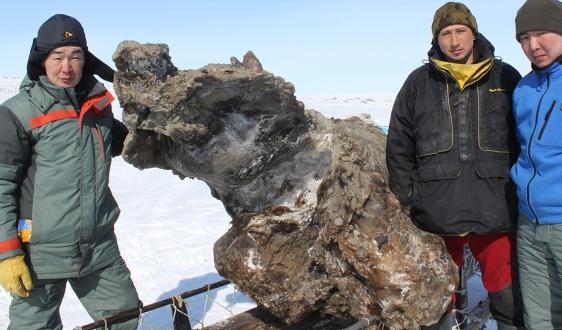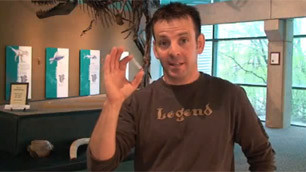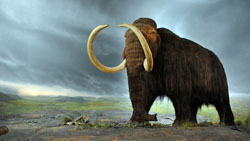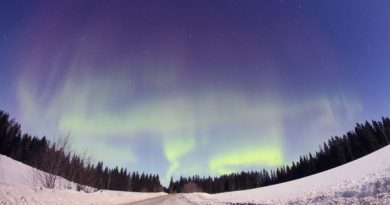Woolly mammoth carcass discovered in Russia raises exciting possibilities

The recent discovery of a well-preserved woolly mammoth carcass and mammoth blood on a Siberian Island has the potential to “raise the ceiling” on scientific research on extinct species, say Canadian researchers who work with mammoth DNA.
“There’s what looks to be fairly well-preserved blood, which leads to the possibility that there’s intact blood cells,” said Kevin Campbell, a University of Manitoba physiologist who was contacted this week by the Russian researchers who found the mammoth and was asked to collaborate with them.
The researchers from the Research Institute of Applied Ecology of the North at North-Eastern Federal University in Yakutsk, Siberia, are eager to work with Campbell because he has previously used mammoth DNA to get bacteria to generate the mammoth version of hemoglobin — the protein in red blood cells that carries oxygen.
Campbell’s study, published in Nature Genetics in 2010, found that the mammoth hemoglobin has adaptations that make it much better at delivering oxygen at cold temperatures than the hemoglobin of the mammoth’s close living relatives, elephants. That may have helped mammoths survive the extreme climate of their Arctic environment.
Campbell told CBC News that he would be keen to be able to test the behaviour of mammoth hemoglobin in actual blood.
“It’s one thing to get a DNA sequence or a protein sequence out of an extinct species. It’s quite another thing to measur
e a living attribute or something that you would measure from a living animal,” he said.
“To me, that would really raise the ceiling, scientifically speaking, of any sort analysis of an extinct species.”
The mammoth carcass and blood were found on Maliy Lyakhovsky Island in the Novosibirsk archipelago in the East Siberian Sea, North-Eastern Federal University announced this week. The lower part of the mammoth’s body was completely buried in the ice and the blood was found in pockets of ice underneath the animal’s belly.
Intact blood proteins possible

Campbell noted that in photographs, the animal’s muscle tissue is pink rather than the brown colour it turns when the proteins are damaged and oxidized, indicating that it is “extremely well preserved.” The blood also appears reddish.
Even if no blood cells are intact, it’s still possible that some hemoglobin is, Campbell said.
“Proteins are a bit tougher than DNA,” he said.
Hendrik Poinar, a geneticist at McMaster University in Hamilton, Ont., who is piecing together the woolly mammoth genome from fragments of DNA extracted from other well-preserved carcasses, said he is also interested to find out whether or not any cells in the newly discovered mammoth carcass are still intact.
“It’s never been reported yet,” he said. But, he added, “ultimately that’s the hope.”
An intact cell could possibly be used to generate a cell line that would make cloning a lot easier than DNA alone.
“If you did have a cell line, then obviously it would be a lot quicker to get a woolly mammoth, that’s for sure,” Poinar said.
However, he doubts that even a carcass this well preserved could yield any intact cells.
“I guess it’s not outside the realm of possibility, but I would be floored [if it were the case],” he said. That’s because enzymes in the bacteria that normally live inside animals such as humans and mammoths quickly start chewing up cells and DNA as soon as the animal dies, unless they are flash frozen or dried very quickly.
Carcass may yield good DNA
Nevertheless, the carcass may still yield better DNA in much longer pieces than other mammoths.
“I would say it probably is a phenomenally well-preserved mammoth that has good DNA,” Poinar said. “The better the DNA, the more likely we get closer to the true genome, which means ultimately if people’s desires are to clone something, you get something closer to the real deal.”
Poinar said he recently heard from a scientist he collaborates with who was asked by the Russian researchers whether the team would like to have a look at the carcass.
“Yeah, of course we would,” Poinar said.

Blood raises puzzling questions
Campbell said one thing that intrigues him is how the blood sample was even preserved for so long — mammoths died out over most of their range around 10,000 years ago, and some specimens that have been discovered in the Arctic are far older than that.
He’s also puzzled by why the blood remained liquid at temperatures well below the freezing point of water.
He doubts the possibility raised by the Russian researchers that mammoth blood had natural antifreeze properties. “I’m skeptical about it,” he said.
He suggested that it’s possible that the breakdown of proteins within the blood may have lowered its freezing point or antifreeze-producing bacteria got into the blood.
However, he said the only way to tell would be to test it.



